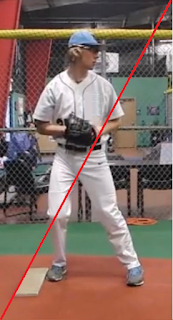How “you” control “your body”.
“You” can only move
when “your body” senses your weight is between your knees.
- “You” control your movements.
- “Your body” instantly reacts to the way “you” decide to move.
- “Your body” only cares about getting your weight centered between your knees.
- “Your body” doesn’t care how you want your body to move.
- Fortunately, “your body” follows very predictable reaction patterns.
“You” have control
over your movements. “Your body” uses obvious reaction patterns to produce what
you see.
How to “you” create a productive front leg lift?
If you’re like most of the Pitchers we work with, “you” generate
a productive front leg lift by thinking to (1) lift and push your front heel
toward the corner base while “you” simultaneously (2) turn your hands to point
your thumbs toward your knees.
Your front leg action creates an all-important separation
between your knees while your simultaneous arm action stops any second-to-home
core tilt.
- These actions combine to get your throwing arm to instantaneously respond to your stride.
- These actions create a vertical axis around which your body can rotate.
- These actions keep your glove arm free to rotate down the mound.
- These actions allow “your body” to deliver every pitch into a very tiny target window.
When “you” only lift your front leg, “your body” places all your
weight over your back foot.
- To move your body toward your target, “you” must create a forward weight shift.
- When “your body” senses a forward weight shift, you end up with a core tilt.
- With a core tilt, “your body” won’t let you complete your delivery until your core move back to vertical.
- The more your core needs to move to vertical, the larger your target area.
A productive front leg keeps your weight centered within
your knees and frees your arm to move the way “you” want.
Your front leg lift separates exceptional from ordinary.
Ending your front leg lift with a vertical core is a
reaction.
Treating your vertical core as
something “you” do and not a consequence of your actions is a complete waste of
your time.
When you use your legs to keep your core vertical into your
front leg lift, you produce exceptional results. When your legs create a core
tilt, you never really know where your next pitch will end up?
Stop aiming and start pitching.
Bookmark this blog and, next week, we’ll go into how “you”
use your front leg lift to get your legs to produce eye-popping results.
Let us know how you’re doing?
When you apply these last couple of blogs and still find yourself struggling with your command, send us a pitching motion video or attach a comment to this post. We’ll use your video and comments to resolve the movements standing in the way of you being exceptional.
When you apply these last couple of blogs and still find yourself struggling with your command, send us a pitching motion video or attach a comment to this post. We’ll use your video and comments to resolve the movements standing in the way of you being exceptional.
Tell a friend!
Know a Pitcher struggling on the mound? Make sure to share this blog with them!
Know a Pitcher struggling on the mound? Make sure to share this blog with them!
Want to fast track your personal improvement? Please feel
free to contact me.
Skip Fast
Expert
Pitching Coach
Professional Pitching Institute
Professional Pitching Institute
E-Mail: skip@propitchinginstitute.com
Cell or Text: 856-524-3248
Cell or Text: 856-524-3248
Copyright ©
2018



